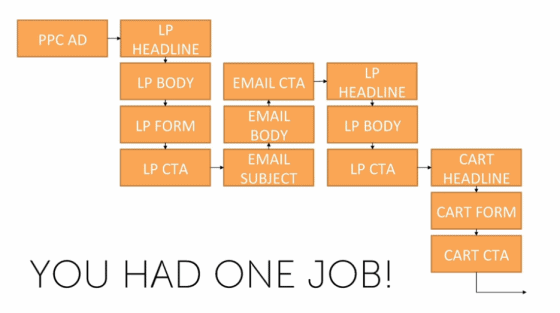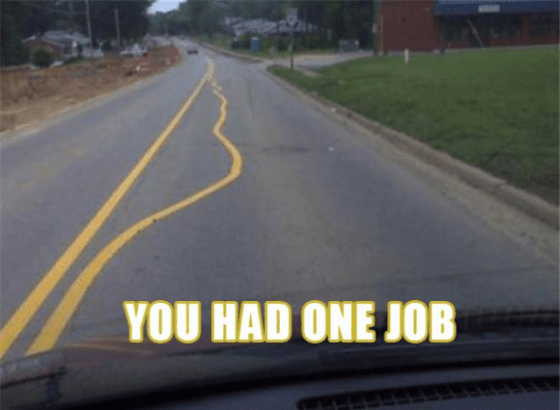
Editor’s note: To celebrate the launch of The Conversion Marketer’s Guide to Landing Page Copywriting, it’s Copywriting Week on the blog! Stay tuned for more copywriting-themed posts that will help make you a better writer and a smarter marketer.
I hate to tell you this, but… you’ve been lied to all this time. Most of everything you’ve been told about copywriting is complete BS. Crap. Nonsense. Hogwash.
It sucks, but don’t fret. At this year’s Call To Action Conference, conversion copywriter Joanna Wiebe set things straight.
It’s not easy calling out the great copywriting legends like Ogilvy and Caples, but someone’s gotta do it. And quite frankly, we’re glad it’s Joanna – with over 10 years of copywriting and A/B testing experience, she literally wrote the book on landing page copywriting.
In her CTAConf talk, Joanna challenged so-called “golden copywriting principles” which come from a time where print ads and billboards were dominant across marketing departments and ad agencies. Because we live in a different world now, Joanna explained, old-school copywriting principles have to be tested.
In this post, we’ll deep-dive and dissect one of the copywriting misconceptions, but be sure to check out Joanna’s CTAConf presentation video in full. In it, you’ll find plenty of gold nuggets that will shake what you “know” about copywriting – to make you a smarter marketer who runs more successful campaigns.
Sorry Ogilvy, but the headline is not god
If you’re a marketer, I’m willing to bet you’ve read this quote before:
“On the average, five times as many people read the headline as read the body copy. When you have written your headline, you have spent eighty cents out of your dollar.” – David Ogilvy
All hail the almighty headline! It can grab visitors’ attention. It can express your unique value proposition. It can convince people to buy your product. It can help you rank for a keyword. It can do everything you want and more!
In other words, your headline carries a lot of weight and importance. And it has many jobs, right?
Wrong. Sorry Ogilvy, but times have changed.
As Joanna explained, if you put too much pressure on your headline and give it too many jobs, everything else will fall apart.
Star athletes don’t play every position and movie stars don’t play every part. They specialize. It’s tempting to fall for the Renaissance Man, but the truth is that he doesn’t exist when it comes to copywriting for conversion.
If your headline does too many things at once, it will be mediocre at everything. As Joanna explained, your headline copy should do one thing, and it should do it really well:
It should keep your visitors’ attention on your landing page.
That’s it, that’s all.
The power of one: Every element on your landing page has one job
The same (shockingly simple) logic extends to every element on your landing page.
Your headline, like Joanna said, is to entice visitors to keep reading. Your body copy should break down the benefits of your offer. Your opt-in form copy should get people to complete it. Your CTA copy should entice people to click.
Every headline, every button… @copyhackers at #CTAConf via @unbounce @beymour #BIZBoost pic.twitter.com/9z4cVaUqyz
— Mohd. Imran (乇мմ™) (@TheSoulfulEMU) September 14, 2014
In her recent ebook, Joanna explains that you should think of your landing page elements as workers on an assembly line:
Every job must be done well to keep the conveyor belt going. If even one person along the line screws up, it makes it very difficult for the other workers down the line to do their job.
In other words, your landing page elements aren’t acting independently. Even though each individual element has its own job, they’re all working together toward the same goal – like players on a sports team.
To that end, every page needs to have one goal for elements to work toward – and one goal alone.
Do you really need to include a social share button when you just want them to sign up for a new trial? The answer is no.
This mindset plays into your landing page’s attention ratio. In a truly optimized campaign, your attention ratio should be 1:1. Because every campaign has one goal, every corresponding landing page should also only have one call to action.
Every piece of your marketing campaign has one job
Guess what?
The “one job” philosophy also extends to every element of your marketing campaign.

Your PPC ad copy should get your visitors to click. Your email subject line should get people to open your email. Your email body should heighten curiosity. Your email CTA button copy should get people to click through.
Don’t overextend your marketing and expect all of your campaign elements to be everything to everyone. Instead, allow each of the pieces of your marketing campaign to do their unique, pre-assigned job.
If they do it well, you’ll have a high-converting landing page and a successful marketing campaign.
Bonus: The “one job” approach makes your A/B testing more effective
When you have a clear idea of what each of your copywriting campaign elements should be doing, then optimizing for that “one job” is simple.
Whether the goal is increasing conversion rates, open rates or click-through rates, understanding what you’re aiming for makes getting there that much easier.
For example, if you’re A/B testing your email subject lines, it can be confusing to know whether you should be minding your open or click-through rates.
But the “one job” approach takes away some of the guesswork. Just like every other piece of a marketing campaign, an email subject line has one job: to get subscribers to open.
Subject lines have one job = Opens #CTAConf @copyhackers #emailmarketing
— Alex Harris (@alexdesigns) September 12, 2014
By breaking down all the elements of your marketing and optimizing them for their one job, your campaigns will achieve greatness.
You had one job…

Before you launch your next marketing campaign, be sure that every element of your campaign is actually performing its one job.
Don’t expect too much from a single element. Don’t give a piece of copy too many jobs, expecting it to work miracles. Don’t put too much pressure on any one piece of your marketing campaign.
If you give one element more responsibility, it will hurt everything else.
Over to you – have you been expecting your landing page elements to do more than one job?
![]()

